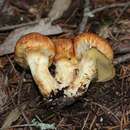fi
nimet breadcrumb-navigoinnissa


Suillus caerulescens is an edible species of bolete fungus in the family Suillaceae.[1] It was first described scientifically by American mycologists Alexander H. Smith and Harry D. Thiers in 1964.[2] It can be found growing with Douglas fir trees.[3] Its stem bruises blue, which sometimes takes a few minutes.[1]
The cap is yellowish to reddish brown, sometimes with streaks from its darker center.[3] It ranges from 5–15 cm (2–6 in) in diameter, shaped convex to flat, and viscid when wet,[4] sometimes with veil remnants on the edge.[3] The flesh is yellowish,[4] as are the pores.[3] The stalk is yellowish to brown, darkening with age, 2–8 cm tall and 1–3 cm wide, and bruises bluish at the base;[4] it sometimes has a faint ring.[3]
While edible, it is considered of poor quality.[4]
Suillus lakei is fairly similar.[4]
Suillus caerulescens is an edible species of bolete fungus in the family Suillaceae. It was first described scientifically by American mycologists Alexander H. Smith and Harry D. Thiers in 1964. It can be found growing with Douglas fir trees. Its stem bruises blue, which sometimes takes a few minutes.
The cap is yellowish to reddish brown, sometimes with streaks from its darker center. It ranges from 5–15 cm (2–6 in) in diameter, shaped convex to flat, and viscid when wet, sometimes with veil remnants on the edge. The flesh is yellowish, as are the pores. The stalk is yellowish to brown, darkening with age, 2–8 cm tall and 1–3 cm wide, and bruises bluish at the base; it sometimes has a faint ring.
While edible, it is considered of poor quality.
Suillus lakei is fairly similar.
Suillus caerulescens je grzib[1], co go ôpisoł A.H. Sm. & Thiers 1964. Suillus caerulescens nŏleży do zorty Suillus i familije Suillaceae.[2][3] Żŏdne podgatōnki niy sōm wymianowane we Catalogue of Life.[2]
Suillus caerulescens je grzib, co go ôpisoł A.H. Sm. & Thiers 1964. Suillus caerulescens nŏleży do zorty Suillus i familije Suillaceae. Żŏdne podgatōnki niy sōm wymianowane we Catalogue of Life.